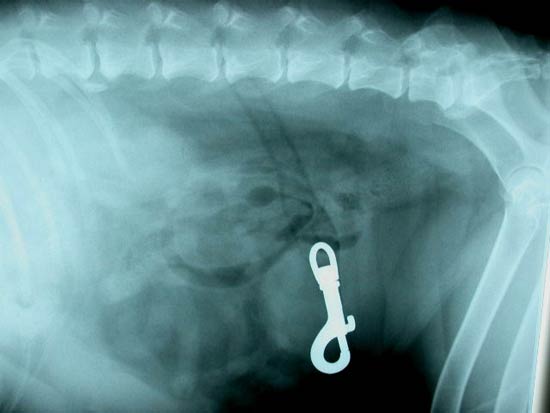Dogs have strong jaw muscles, which allow them to tear and chew many things. We have to remember, however, that their gastrointestinal tract is almost the same as a human’s. Anything (aside from dog food) that we would not eat, our dogs should not eat.
There are three categories of foreign objects that dogs tend to swallow: balls, rocks, and other things. I have seen golf balls, Super Balls, rubber balls, and even a tennis ball removed from dogs’ stomachs and intestines.
Many dogs are rock chewers and eaters. Whether they intend to swallow the rock they are chewing on or do it by accident, it often ends up in the stomach or intestines.
A rock in the stomach will cause intermittent vomiting but rarely obstruction. If the rock is small enough to pass through the pyloric valve from the stomach into the intestines, it will often lodge at the ileocecal junction between the small intestine and large intestine. This can cause an intestinal obstruction that is life threatening if not corrected surgically.
My Gordon Setter, Gabbee, has swallowed rocks all of her life. When she was a puppy, I removed a rock from her stomach the day after she won Reserve Winner’s Bitch at a regional specialty. The rock sits in the pewter cup she won that day.
Gabbee is now over 12 years old. We have a pea-stone paddock that she occasionally decides to feast upon, but the pea stones are small enough to just pass through her gut.
The remaining category includes all of the other toys, treats, and household items that dogs can eat. These include items that can get stuck in the gut, as well as items that can just cause a gastrointestinal upset—vomiting or diarrhea.
I have some patients that like to eat bars of soap, a natural laxative. Sponges are another favored snack of dogs. These are difficult to identify without a barium series. When it comes to treats and toys, we must realize that dogs come in all sizes, and some toys that are appropriate for some small dogs are inappropriate for large dogs.
Small squeaky toys and flimsy rubber or plastic toys are not suitable for dogs that can swallow them or easily tear them apart and swallow pieces. Many dogs like to tear out the squeaker and swallow it—and this can get stuck inside small and medium-sized dogs.
Sometimes a dog will decide to feast on a major project. One of my patients, a German Shepherd Dog, was determined to see if she could chew and eat an entire leather toolbelt—rivets and all.
The Vet Recommends …
The most important recommendation I make to my clients is that dogs should eat their food and treats, and play with their toys. They should not be consuming their toys. I am not in favor of rawhide treats, pig ears, or cow hooves. I have had to surgically remove these too many times. There are plenty of commercially available toys to satisfy a dog’s chewing needs that do not break down into bite-sized pieces.
The less that we veterinarians have to be introduced to your dog’s insides, the happier we, you, and your dogs will be.
Article courtesy AKC Canine Health Foundation; X-ray: University of Sydney


